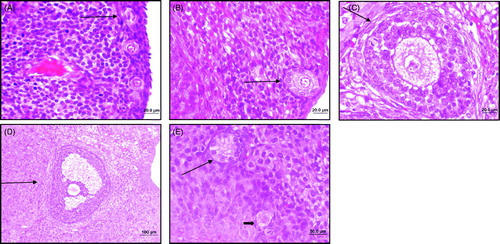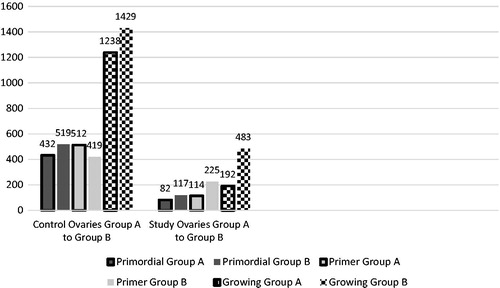Figures & data
Figure 1. Histologic sections showing follicle types. (A) Primordial follicle (primary oocyte enclosed by spindle-like granulosa cells) shown by arrow, Hematoxylin-eosin (HE) stained section. (B) Primary follicle (primary oocyte enclosed by a single layer of granulosa cells exhibiting first signs of the formation of the zona pellucida around the oocyte) shown by arrow, HE. (C) Secondary follicle (primary oocyte enclosed by more than one layer of granulosa cells) shown by arrow, HE. (D) Antral follicle (formation of an antral cavity due to collection of fluid with glycoprotein) shown by arrow, HE. (E) Atretic (deformed follicles exhibiting pyknosis in granulosa cells and eosinophilia with oocyte involution) primordial (shown by long arrow) and atretic primary follicles (shown by short arrow), HE.

Table 1. Follicle numbers in primordial, primary, and growing follicle subgroups and atresia rates in Group A.
Table 2. Follicle numbers in primordial, primary, and growing follicle subgroups and atresia rates in Group B.
Figure 2. Comparison of number of follicles of control and study ovaries in Group A to Group B. Left side of the figure demonstrating the similar number of primordial, primary, and growing follicles in control ovaries of both Group A (unilateral oophorectomy was carried out at day 0, the remaining study ovary was removed by relaparotomy after 4-vinylcyclohexene diepoxide (VCD) administration for 15 days) and Group B (unilateral oophorectomy was carried out at day 0, the remaining study ovary was removed by relaparotomy after VCD administration for 15 days followed by DHEA daily for 45 days). Right side of the figure demonstrating the relatively higher numbers of primordial, primary, and growing follicles in study ovaries of Group B compared to Group A.

